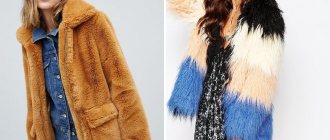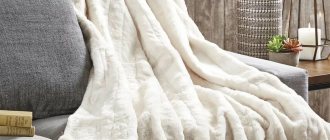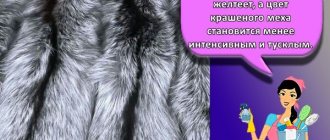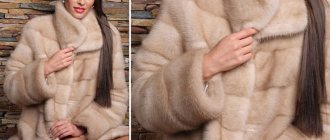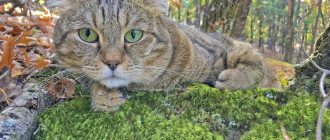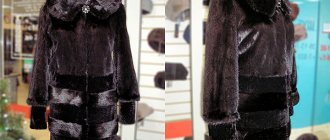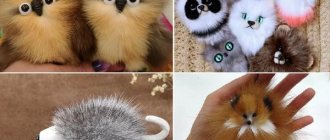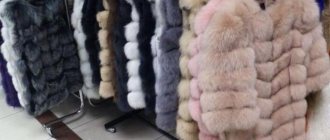Features of fur
Honorik was developed in the second half of the twentieth century. This animal appeared by crossing a ferret and a European mink. From ferrets they only got large ears with a white stripe. But from the mink, Honorik adopted many external qualities.
The animal's fur is very similar in appearance to sable. The thick underfur is evenly covered with a shiny awn. The color of the coat is close to the colors of dark sable. Unlike mink, honorik has a heterogeneous color with guard hair and lighter underfur. This animal is larger than its parents.
How not to confuse an honorary with a mink?
Honorik fur coats are very valuable, as their fur has good water-repellent properties. The animal acquired this quality after becoming perfectly accustomed to the wild. Animal fur is not inferior in its beauty. In addition, Honorika fur is very warm and pleasant to the touch. Reviews from owners of such fur products indicate that in terms of wear time they are close to mink products.
For connoisseurs of fur products, it will not be difficult to distinguish fur coats from Honorik in the photo from mink coats. But to be confident in your choice, you should consider three important components:
- fur color,
- skin sizes,
- type of down,
- price of a fur coat.
The color of the honorik is darker than that of the mink, and the undercoats are lighter. Mink has both fur and downs of the same shade. The size of the skin also matters. For a mink it does not exceed the parameters 15x15. If the skins are larger, then it is an honorik.
The honorik's fur is longer, but the fur is much less frequent than that of the mink. The price of such fur coats is cheaper, but they are not inferior in quality to mink ones. The fur of these animals is very valuable, since in some respects it is superior to the fur of its “parents”.
Women's fur coat models
Honorik fur coats in the catalog are presented in a wide variety of model variations. The sizes and shades of the skins of this animal allow you to sew fur coats of a wide variety of styles. The catalogs present the most popular models.
The trend is classic silhouettes, complemented by some modern elements. Light flares highlight many fur coat models. Large, voluminous hoods have become an adornment of many women's styles.
The main fashion trends of recent years can be identified:
- simplicity of styles,
- classic elements,
- presence of a hood,
- no collar,
- combined models,
- color contrast,
- original accents.
Long fur coat models
Long, straight-cut honorik fur coats, shown in the photo, are considered the standard of elegance and femininity. Judging by the reviews of owners of such fur coats, they are universal for any style of clothing. Below-the-knee length models look great with or without corset belts, leather belts. Interesting models of fitted styles without collars and with straight sleeves. They harmonize perfectly with combinations of leather or other fur inserts.
The hit of recent seasons has been voluminous long women's fur coats in straight styles and with large hoods. Dark natural shades of honorik fur go perfectly with such models. The sleeves of the products vary in size from wrist to 3/4. The catalogs also feature extravagant fur coats with inserts made of leather, suede or decorated with original prints.
Short fur coat models
Women's short fur coats have become a hit in recent fashion seasons. The main trends in short fur coat models:
- fur coats,
- fur coats, cardigans,
- balloons and tulips,
- voluminous sleeves and hoods.
The catalog contains photos of a wide variety of models and styles. Fur coats of a simple cut, midi length, made from plucked honorik fur look original and stylish. Short fur coats with a horizontal cut of the skins without a collar or with an English stand-up collar are very fashionable. They can be complemented by horizontal inserts made of another material, breaking up the silhouette.
Fur coats up to the hips or waist became a hit in all designer catalogs. This length goes well with batwing sleeves. For women of any age and build, products in the shape of “tulips” are suitable. They will help hide waist imperfections or highlight the beauty of your legs.
When choosing a product, you should take into account not only fashion trends, but also the characteristics of fur, and most importantly, its quality and price. Reviews about fur coats from Honorik confirm that choosing something made from the fur of this rare animal will not disappoint, but will delight you with its quality and beauty for many years.
The article will tell you about the different types of fur and their differences.
Reviews
Svetlana, 31 years old. Recently my husband and I bought me this gift - a straight ferret fur coat with a fur belt and a stand-up collar, without a hood. I liked that it is cheaper than mink, and the look is just super! Stylish and tasteful) I endured the winter, wore it almost every day, but it was so soft that I tried not to ride in public transport in it, I regretted it. We have frosts of up to 30 degrees, and it was warm in there! Maybe I didn’t walk for long, but I wasn’t cold. The quality pleasantly surprised me - the fur coat has not deteriorated at all over the winter and looks like new!
Irina, 20 years old. I have a dark brown ferret jacket. I decided not to take a longer one, since I drive – I heard from reviews that the fur wears out quickly if you sit on it. She is very light and warm. I started wearing it in the fall for thin golf, and it wasn’t hot. The lining isn't really hemmed, but that doesn't bother me at all. It got caught in heavy rain once, but it dried in the room and everything is fine. I think I will wear it for many years to come because it is very comfortable.
Mink coats rank first in popularity among Russian women. This fur is beautiful, durable, and has good thermal characteristics. But the cost of such a fur coat is not always affordable for women. Many people save for it for several years, purchasing it for more than one year. But some cunning sellers have learned to pass off fake mink as mink. It is very disappointing to purchase the fur coat of your dreams, which turns out to be not made from mink at all, but, for example, from a ferret or marmot. How to distinguish high quality from counterfeit goods and make a purchase that will last for many years?
How to distinguish mink fur from marmot fur: signs of difference, recommendations for selection
In order to earn as much as possible and achieve maximum personal gain, unscrupulous sellers cut the fur, dye it, apply chemical methods, just to achieve an imitation of more noble furs.
- Wearability is the main difference between mink and no other fur can boast of such qualities. The second feature is grace.
- It is believed that the easiest way to “recognize” a mink is to run your hand across the fur coat “against the grain.” If the fur is very pleasant and soft, but at the same time elastic and easily returns to its original position, it is natural and 100% mink.
- The same cannot be said about marmot fur - it has more elasticity and is not as flexible as mink. This is why the groundhog's pile becomes shaggy, itchy and even breaks.
- A noticeable difference between a marmot and a mink is its uneven hair length (one hair is longer, the other is shorter).
- Often a marmot is sheared and passed off as a mink, but such a fur coat is easy to distinguish, because the marmot’s fur must first be dyed for this, which means it will have a bluish or purple cast.
- A mink always shines beautifully; a marmot may not shine at all in the sun.
Buy from those who are trustworthy
Real American, Scandinavian, Greek mink coats are sold in specialized fur salons and retail outlets from large fur factories. Sellers of this level guarantee the quality of fur and tailoring and provide a significant guarantee. A certificate is issued for each product; its data matches the information on the fur coat tag. On a fake, the tag may say weasel (Rabbit), kolynsky (marmot). A person who does not know English may not pay attention to this. The seller, naturally, will not explain. A real mink tag may only say mink (mink in English) or vison (French).
There are many differences between fake and real mink. To avoid becoming a victim of scammers, you need to study them. A little time, scrupulousness, careful reading of the documentation, and a long-awaited natural product will appear in your wardrobe.
Scandinavian mink is the most famous and popular fur for fur coats all over the world. Products made from this material are of good quality and look very elegant, expensive and presentable. Therefore, millions of women prefer to buy a chic fur coat for themselves.
How to distinguish mink fur from fur: signs of difference, recommendations
INTERESTING: The kolonok is a species of predatory ferret and weasel. Its fur is very similar to mink, since the animal is its close “relative”.
What is the difference between a fur column:
- Its fur is fluffier than that of a mink and is similar to a marten (especially in winter).
- Columna's natural color is light and bright red.
- Fur is considered very practical, as it can withstand wet weather and frost very well.
- The speaker is very soft and delicate
- Those who sew fur coats can say that columnar fur is very pliable and therefore this material is widely used in outerwear collections by modern fashion designers.
- The main difference between column and mink is lower cost and availability.
How to distinguish mink fur from sable fur: signs of difference, recommendations
Like mink, sable is a very soft, smooth and shiny fur. It is very attractive and considered luxurious.
Similarities and differences:
- The quality of sable and mink fur is very similar
- Both types of fur are light and therefore not difficult to wear on the body.
- Sable is much more expensive than mink, since the population of this animal is smaller.
- Due to their high cost, sable fur coats are rare and are increasingly used as decorative trim for hoods, collars and jackets.
- If we talk about quality, sable fur is considered more durable than mink.
- Sable is also slightly warmer than mink, according to experts
- If sable easily tolerates moisture, then mink “treats” water and moisture worse.
Who is a ferret
This small animal is a mammalian predator of the canid family. A litter of ferrets is called puppies, of which there can be about twenty per litter. This is due to the large number of individuals on the planet, which allows them to be used for commercial purposes. Sometimes, of course, ferrets are bred for fur. Related to them are the European mink (hence the similarity of fur), weasel and ermine. The ferret is not a very large animal, growing up to 55 cm in length. Females are always slightly smaller than males. The weight of one individual varies from one to 2 kg, sometimes a little more.
The ferret's body is oblong and narrow with a small neat head, an elongated nose and a long fluffy tail. Ferrets have very short feet with sharp claws that help them hunt, jump, and climb trees. An adult ferret visually resembles a cat, which is what a specially bred albino species was used for two thousand years ago. And in nature, animals live their entire lives in one house, which can be their own or a fox’s hole, a hollow, or just a mound of brushwood.
In addition to albinos, there are three main types of ferrets:
- Steppe ferret (light);
- Forest ferret (common, also black);
- American ferret.
The latter is listed in the Red Book and is subject to artificial population support, therefore it is not used by humans in industry. The remaining two species are found, according to their names, in the forests and steppes of Europe, Russia and China.
How to distinguish mink fur from muskrat fur: signs of difference, tips
Muskrat fur is very popular and is often used for making fur coats.
Features of fur and its differences:
- The cost of muskrat is significantly lower than mink
- Since the muskrat is a waterfowl animal, its fur is resistant to water and moisture. It will not let in either rain or snow. To get rid of moisture, simply shake the fur coat and then lightly comb it.
- The fur is very valuable and looks good, visually very reminiscent of mink.
- The muskrat has very warm fur and is soft to the touch (during life, the animal constantly takes care of its fur: combing it and lubricating it with fat).
- Unfortunately, it is not as durable as mink
- Muskrat hair is thick and quite dense
How to distinguish a sheared mink from sheared nutria fur: signs of difference, tips
Similarities and differences:
- Long or cut nutria hair is always more affordable than mink (several times cheaper).
- When buying a fur coat, the first thing you should pay attention to is its smell and appearance; some nutria products can smell bad and have a greasy sheen.
- The wearability of nutria is less than that of a mink coat, but it can still last ideally for up to 5 seasons (if you treat the coat with care).
- Nutria pile is elastic, but very soft
- A nutria fur coat is very warm, but several times heavier than mink.
- The fur tolerates wet and rainy weather very well
- The pile has a bright tint and is very shiny in the light
- To make nutria fur more like mink, it is cut
- Sheared nutria is velvety and similar to mink (but its difference is the tartness as you stroke the fur).
- Sheared nutria is not as durable as regular nutria (it wears off more and faster).
- Sheared mink does not prick, it is very soft, the fibers are strong.
Kinds
There are several varieties of Scandinavian mink:
- Danish selection, or Kopenhagen Furs. This fur has a smooth, very delicate and rather low spine.
- The Finnish selection, or Saga Furs, has a rough awn and a fairly high pile height.
- "Mixed" Scandinavian mink. For example, a popular option is “Danish corduroy”. Externally, this species is similar to the fur of the North American selection.
High-quality Scandinavian mink is most often sold in Copenhagen, at the Kopenhagen Furs auction. The best options:
- SAGA Royal Mink is considered an exclusive fur.
- SAGA Mink is first grade fur.
Livestock breeders who breed Scandinavian mink have bred a huge variety of natural fur colors of this animal. The most famous and in demand on the market today are brown with a black tint and dark brown. Scanblack receives special attention - such skins make a simply gorgeous mink coat! Scandinavian mink of this color has a pure black tone. Allow only a slight coffee tint.
How to distinguish a sheared mink from a mouton: signs of difference, tips
INTERESTING: Mouton is a fur obtained through special processing of sheepskin.
Differences between a fur coat and its features:
- A mouton fur coat is unlike any other
- It is very dense and heavy
- The pile is stuffed thickly and softly (like plush)
- Mouton fur coats can be worn for a very long time (up to 10 seasons)
- Mouton fur coats are always dyed
- They have a pleasant matte color, some have a light sheen
- The material easily takes any shape for sewing products
- The difference between a mouton and a sheared mink is the thickness of the material, heaviness, and density.
Powder as foundation: how to choose cream powder and how to use it
However, many do not even know what cream powder is, what its features are and how to use it to create the perfect makeup.
What is good about cream powder: the composition of the cosmetic product
Before learning how to use this modern cosmetic product, let's try to figure out what cream powder is, what it is actually needed for and what its advantages are. This universal product, in composition, purpose and action, occupies an intermediate place between ordinary powder and foundation. This popular type of cosmetics can be produced in various forms - from compact to liquid. Each of them has its own advantages and application features.
What is so good about cream powder that it has become so popular among girls and women? The composition of such a cosmetic product, as a rule, contains additional nutrients and moisturizing substances - vitamins, minerals, amino acids, UV filters, aloe vera extracts. This composition provides the skin with additional care, nutrition, hydration, and protection from aggressive environmental factors.
Video: “Fur coats: how not to buy a fake that you’ve been saving for for so long”
They say that the best gift for a woman is a mink coat. Dressing beautifully, a woman feels feminine and confident, and fur gives her image nobility and chic. This is probably why every fashionista dreams of having at least one in her wardrobe. And if you still dream, then you will definitely have it.
But in order for you to enjoy your purchase for many years, it is worth remembering that there are now a lot of fakes, and in order not to fall for scammers, it is important to have a good understanding of how to distinguish mink fur from a fake.
How to distinguish a real mink?
Real mink can be worn well for many seasons. Therefore, it will be very disappointing if a few years after the purchase you find out that you were deceived. We suggest arming yourself with the necessary knowledge for the future on how to distinguish a fur coat from a mink.
Most often, a replacement for mink is the skin of a rabbit or marmot. Rabbit skin is much softer than mink skin, so identifying a rabbit is quite easy. But how can you tell the difference between mink and marmot fur? Mink fur, unlike marmot fur, is the same length and does not prick. Marmot fur, although similar to mink, is more prickly and has different lengths. If you are offered a mink coat, and the fur of the model is of different lengths, rest assured that it is a fake. Seeing your doubts, they may tell you that this is a steppe mink, which is why it has such fur. In fact, the mink does not live in the steppe, but the Mongolian marmot does, or as it is also called, tarbagan. Tarbagan's fur is hard and puffs up in different directions, but if you pull apart the fur of a natural mink, it immediately returns to its previous shape.
It is also worth paying attention to the fact that mink fur has several types, which differ slightly from each other. The most expensive mink is Canadian. It is highly valued due to its thick, medium-length pile and abundant fluff. There is Ukrainian mink, which is also very expensive, but it is inferior to Canadian mink due to the meager down and longer pile.
When you go shopping for new clothes, you may encounter another type of animal that is offered instead of mink. How to distinguish good mink fur from honorik fur? Honorik is an animal that was created by crossing a ferret and a mink. It is very difficult to distinguish its fur from mink and you need to be a specialist to identify a fake. Honoriki's fur is shiny black with thick brown down.
You may also encounter a problem such as dyed mink. How to distinguish dyed mink fur? Today, for the sake of profit, people resort to various tricks, replacing expensive fur with cheaper ones or dyeing it. They are very successful in the field of coloring mink, and sometimes it is almost impossible to distinguish. Therefore, when going shopping, take with you someone who has an idea of how to distinguish natural mink from dyed one.
To avoid any mishaps while shopping, buy expensive furs only in special stores that have a good reputation and can provide a certificate confirming the quality of the product.
Mink coats come in short and long, cut and dyed, white and blue. But now we will not talk about fashion trends, but about how not to fall into the hands of scammers who sell fakes instead of the fur coat of your dreams.
A fur coat is an object of desire for many women, even despite the numerous animal defenders. If you are planning to buy mink, then you need to know how to distinguish real fur from fake. The soft, fluffy, warm pile is very difficult to confuse, but it will turn every representative of the fair sex into a real queen.
Fashionable fur coats
Today, models of fur coats made from Scandinavian mink in pastel shades are at the peak of popularity. In addition, contrasting options are on trend, complemented by elegant black lines.
“Stardust” are also fashionable models. Dark mink fur is decorated with light fibers. The effect is amazing. And such fur coats look expensive and elegant.
If the choice fell on dark shades, then you should pay attention to the following colors:
- Luxurious black.
- Soft chocolate.
- Nice grey.
- Glamorous graphite.
A wide variety of fur coats are made from Scandinavian mink:
- Manto.
- Bow-tie fur coats.
- Classic models.
- Styles in Chanel style.
Both long and short models are in trend. Sleeves can also be of different lengths. Therefore, every representative of the fair sex today will be able to choose a beautiful mink coat for herself. The main thing is that it emphasizes all the advantages of the figure, hides flaws and fits perfectly into the overall style of clothing.
